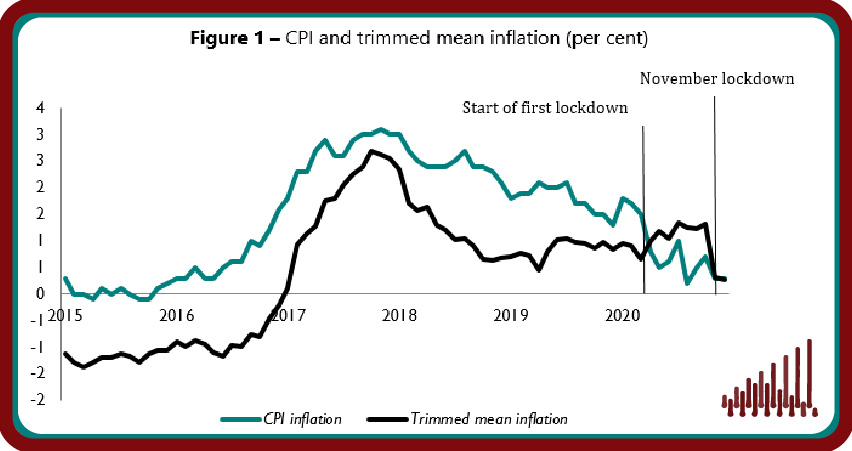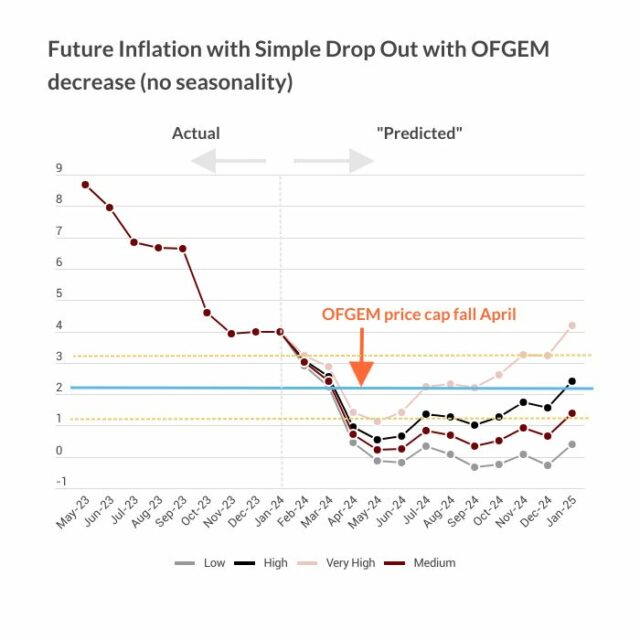- Home
- Publications
- Continued Lockdown Measures Keep Underlying Inflation Low
Continued Lockdown Measures Keep Underlying Inflation Low
 Pub. Date
Pub. Date
 Pub. Type
Pub. Type

Continued lockdown measures keep underlying inflation low
Main points
- Underlying inflation remained unchanged at 0.3 per cent in the year to December 2020, as measured by the trimmed mean, which excludes 5 per cent of the highest and lowest price changes (figure 1).
- At the regional level, underlying inflation was highest in Northern Ireland at 1.8 per cent and lowest in the South West which saw a 0.5 per cent decline in the year to December 2020 (table 1).
- 22.9 per cent of goods and services prices changed in December, implying an average duration of prices of 4.4 months. 6.5 per cent of prices were reduced due to sales, 5.1 per cent fell for other reasons and 11.2 per cent recorded increases (figure 2).
- We expect the downward pressure on inflation to continue in the short-term as we forecast the UK economy to contract in the first quarter of the year due to the effects of the January lockdown.
- CPI inflation is likely to pick up in the second half of the year but stay below the Bank of England’s target of 2 per cent in the year to December 2021.
“Headline inflation increased to 0.6 per cent in December, up from the 0.3 per cent recorded in November. Our measure of underlying inflation, which excludes extreme price movements, remained unchanged at 0.3 per cent in December. Our analysis at regional level indicates that regions that entered higher tiers of restrictions in December experienced marked decreases in consumer prices during the month. Inflation is likely to remain subdued in the short-term due the effects of continued lockdown measures.”
Janine Boshoff
Economist, Macroeconomic Modelling and Forecasting
Related Blog Posts



What is the Current State of the UK Economy?
Paula Bejarano Carbo
Stephen Millard
26 Feb 2024
7 min read

Related Projects
Related News


Why it’s not worth worrying that the UK has technically entered a recession
26 Feb 2024
4 min read

1.2 million UK Households Insolvent This Year as a Direct Result of Higher Mortgage Repayments
22 Jun 2023
2 min read

The Key Steps to Ensuring Normal Service is Quickly Resumed in the Economy
13 Feb 2023
4 min read
Related Publications
Recessionary Pressures Receding in the Rearview Mirror as UK Economy Gains Momentum
12 Apr 2024
GDP Trackers
Related events

Summer 2023 Economic Forum

Spring 2023 Economic Forum

Winter 2023 Economic Forum

Autumn 2022 Economic Forum

Summer 2022 Economic Forum

Spring 2022 Economic Forum

Winter 2022 Economic Forum

Autumn 2021 Economic Forum






